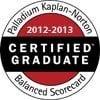ERP Implementation Proposals
Sometimes, you need to be very thorough and complete when accomplishing a goal, using whatever means are at your disposal.
For instance, one time, my mother needed some help in getting a very persistent salesman off her front yard.
Just so you know, no salesmen were harmed in the making of this blog.
It played out something like this - When my brother and I were just young lads a car stopped at our house and out came two men selling replacement windows.
They showed graphic pictures of people who had been burned in their home because they didn’t have the kind of windows these men were selling. They just would not leave, no matter how much our mom encouraged them to do so.
My brother and I decided to help her out a little. We went around the house and came out again carrying an empty bomb case and asked her to admire what we had found.
Those two men left on a run, not realizing the “bomb” was only a casing left over from World War II that our grandfather had found and given to us.
So from a project completeness perspective, i.e., getting the salesman gone, it took a little more effort than just asking them to leave!

These will get your attention
When you are writing an RFP for SAP implementation proposals, you sometimes find you also need some help to get everything completed.
Perhaps you’re a business development manager in a company that doesn’t explicitly focus on SAP ERP software, but rather, your solution proposal includes an SAP system among many other technologies and services, a not uncommon situation. That means you're not expert at scoping out the human resources needed to implement an SAP ERP System (Enterprise Resource Planning System).
ERP Implementation Best Practices
SAP RFP Proposal Quality Assurance
Though I cannot tell you how to formulate a complete proposal for the non-SAP part of your proposal (but we do provide an ERP implementation proposal template), I can tell you that in order to get the SAP part right you should do the following:
- Review our SAP Mindmap, which you can get by clicking the link and downloading it.
SAP has 16 core modules, such as SAP FICO, SAP SD, SAP PS, SAP PM, SAP EWM, SAP MM, numerous 'new dimension' products, and multitude of solutions they have acquired, such as SuccessFactors, BusinessObjects and many others.
In order to put together winning proposal, you're going to need to understand what solutions SAP has to offer. No one person can know this. The SAP Mindmap is a solid foundation.
For very large bids, you'll need to put together a bid team. That team will need access to expertise. If you, proposal manager, don't have a fairly deep understanding of SAP, it will be almost impossible to determine what expertise you need to answer many parts of complex RFPs. - Obviously review the initial SAP RFP as provided by the client, if available.
This is not the place to save time. This is the place to read and understand both the business needs and the fine print. - Review the pre-sales demo’s and scripts.
This will be critical inputs to your eventu ERP implementation proposal. These demo's are often where true detailed requirements are uncovered. Well written RFPs will provide for the ERP implementation partner to suggest updates to the original RFP that reflect what comes out of these pre-sales demonstration events. - Review and ensure all notes taken before, during and after all demo’s are incorporated into the proposal.
Your final ERP implementation proposal should not only reflect the concerns of key stakeholders uncovered during the pre-sales demo's, but should also reflect best practices that you, as the SAP ERP implementation partner, are recommending. - Use a requirements traceability matrix to ensure completeness.
Your SAP project manager need to have this requirements traceability matrix throughout the project. He will use during the Project Preparation phase all the way through to the Go Live phase.
The project plan, prepared by project manager, will need to incorporate these requirements as deliverables. This author, a Senior SAP Project Implementation expert, uses this critical document, along with the signed Statement of Work (SOW), to validate that the Business Blueprint actually covers all agreed upon requirements, including all approved change request. - Review and incorporate Value Engineering work into the proposal, if appropriate.
There will be bumps in the road on most ERP projects. Having a strong financial business case helps keep everyone focused on the goal.
It's a good time to introduce the concept of TCO or Total Cost of Ownership at this point as well. Though you won't have all the data provide a complete TCO picture, you can provide much of the answer. - Incorporate Key Performance Indicators (KPIs) as agreed upon between the client and yourself.
In this case, KPIs are referring to the execution of the project. For example, perhaps your invoicing is tied to milestone achievement. Another example is usually meeting the ERP implementation schedule. - Define success in the contract and how it will be signed-off and by whom.
This ties back to having the traceability matrix. Getting sign-off from clients that a requirement has been met is one of the tougher challenges of an ERP project. - Ensure the required software licenses are available and that they match up to the requirements in the RFP.
In other words, make sure the client has the tools you will need to work with to get the implementation done. Clients hate hidden costs, and this is one of those areas where additional costs are frequently encountered. - In those cases where SAP will be implemented or additional functionality will be rolled out on an existing implementation, ensure an adequate system level architecture diagram exists.
New business processes usually involve detailed analysis and design. Your ERP implementation plan will be affected by new business process that you need to incorporate into your project management plan. - Ensure all assumptions that are known are stated in the proposal, including user counts, locations, entities, and sizing assumptions.
One additional area that requires special attention is data cleansing and data migration. Though SAP provides a number of tools and approaches to migrating data, i.e., the LSMW, it is hard to estimate the size of this task with taking samples of the existing data. This, of course, requires additional resources, which must be accounted for. - If significant development effort is anticipated, ensure the methodology is both understood and appropriate for the environment, i.e., scrum, SAFe. This is especially critical when a large number of WRICEF items are already known or expected to be identified.
No matter what approach you take to preparing your implementation plan, ultimately, your success as a project manager will depend upon having the entire implementation team trained in the appropriate implementation process. - If third party auditing will be employed by the client, ensure both you and he are in agreement on this point. All third party audits must comply with the Statement of Work.
The first step you should take in this scenario is to get to know the auditor and to thoroughly understand what they think their role is. It should never be to make personnel staffing decisions, as that belongs to the project manager. - Ensure your solution proposal is executable and at a profit.
Because winning an ERP implementation project is highly desirable for any ERP vendor, once won, there is a tendency for day to day activities to keep the project manager from keeping an eye on cash management.
While the ERP implementation process can be complex, during the first few months of any implementation, can be challenging. That's why it's imperative to set up a cost tracking system from before day one.
Of course, there is no 100% sure way to ensure a proposal is complete, but there is plenty of experience out there to get you to 'good enough'.
RFP Evaluation Whitepaper
But if you want be sure you have covered the most important elements of an SAP RFP Evaluation, then you should get our whitepaper on evaluating an RFP response so you can make an effective selection and be assured of project success.
People who read this also read:
- How Do You Manage Massive Commercial Real Estate Holdings
- Request SAP HANA Consulting Support
- Need Help With Your RFP
- What are 2 Primary Focus Areas for SAP Airline Customers?
- 10 Critical Chain Project Manager Tips
- Learn What is Catch Weight Management
- 5 Surprising Reasons Enterprises Don’t Use An ERP
- Understanding Embedded Systems vs SAP HANA
- 1 Key Tip When Upgrading from SAP BW 3.X to BW 7.X [Checklist]
- 10 Advanced SAP BW Project Estimation Techniques [Online Tool]
- 3 Ways to Design KPIs Using SAP Solution Map Composer
- Top 10 Benefits for Financial Analysis in the Latest SAP EP4
- Learn What Tools To Use To Investigate IS-Mill Functionality
- BusinessObjects Explorer Best Practices
Enterprise Growth. Engineered
SAP BW Consulting, Inc. is a high-performance consulting firm built for companies that run on SAP but want more than just technical implementation. We engineer profitability using a precision blend of SAP expertise, Balanced Scorecard strategy, and performance marketing firepower — all delivered by executive-level consultants.



